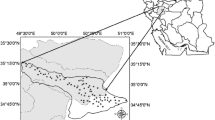Abstract
As a result of serious groundwater pollution in the northern Ordos Cretaceous Basin, China, it is necessary to carry out groundwater quality and groundwater vulnerability assessment. In this study, groundwater quality was assessed by principal component analysis (PCA) and groundwater vulnerability was assessed by a modified DRASTIC model. Then, the assessment results of groundwater vulnerability were verified by comparing the corresponding relation between groundwater vulnerability and groundwater quality. Finally, the map removal method was utilized to analyze the parameter sensitivity of groundwater vulnerability. The research results show that more than half of the study area has moderate degree of groundwater pollution. Groundwater is polluted serious in the south of study area. The groundwater vulnerability assessment results based on modified DRASTIC model are more consistent with actual conditions of study area. The high groundwater vulnerability is mainly distributed in middle east of study area. The sensitivity of the groundwater vulnerability from largest to smallest are impact of the vadose zone, depth to water, net recharge, type of soil media, type of aquifer media, and topography. Above researches provide a good approach for assessing groundwater vulnerability accurately and a strong scientific basis for protecting the groundwater environment across the study area.



Similar content being viewed by others
References
Almasri MN (2008) Assessment of intrinsic vulnerability to contamination for Gaza coastal aquifer, Palestine. J Environ Manag 88(4):577–593
Al-Zabet T (2002) Evaluation of aquifer vulnerability to contamination potential using the DRASTIC method. Environ Geol 43(1–2):203–208
Chandoul IR, Bouaziz S, Dhia HB (2015) Groundwater vulnerability assessment using GIS-based DRASTIC models in shallow aquifer of Gabes north (south East Tunisia). Arab J Geosci 8(9):7619–7629
Ghazavi R, Ebrahimi Z (2015) Assessing groundwater vulnerability to contamination in an arid environment using DRASTIC and GOD models. Int J Environ Sci Technol 12(9):2909–2918
Guo JM, Wang H, Yang GQ (2012) Evaluation of vulnerability to pollution of groundwater in Ordos Basin of Cretaceous system. J Anhui Agric Sci 40(9):5470–5473
Hou GC, Zhao MS, Wang YH (2006) Groundwater investigation in the Ordos Basin. China Geological Survey, Beijing
Howard KWF, Howard KK (2016) The new “Silk Road economic belt” as a threat to the sustainable management of Central Asia’s transboundary water resources [J]. Environ Earth Sci 75(11):1–12
Kazakis N, Voudouris KS (2015) Groundwater vulnerability and pollution risk assessment of porous aquifers to nitrate: modifying the DRASTIC method using quantitative parameters. J Hydrol 525:13–25
Kumar S, Thirumalaivasan D, Radhakrishnan N, Mathew S (2013) Groundwater vulnerability assessment using SINTACS model. Geomat Nat Haz Risk 4(4):339–354
Li P, Qian H, Howard KWF, Wu J (2015) Building a new and sustainable “Silk Road economic belt”[J]. Environ Earth Sci 74(10):7267–7270
National Research Council (1993) Ground water vulnerability assessment: contamination potential under conditions of uncertainty. Committee on techniques for assessing ground water vulnerability. Water science and technology board, commission on geosciences, environment, and resources. National Academy Press, Washington DC, p 179
Pavlis M, Cummins E (2014) Assessing the vulnerability of groundwater to pollution in Ireland based on the COST-620 pan-European approach. J Environ Manag 133:162–173
Prasad RK, Singh VS, Krishnamacharyulu SKG, Banerjee P (2011) Application of drastic model and GIS: for assessing vulnerability in hard rock granitic aquifer. Environ Monit Assess 176(1–4):143–155
Rahman A (2008) A GIS based DRASTIC model for assessing groundwater vulnerability in shallow aquifer in Aligarh, India. Appl Geogr 28(1):32–53
Rebolledo B, Gil A, Flotats X, Sánchez JÁ (2016) Assessment of groundwater vulnerability to nitrates from agricultural sources using a GIS-compatible logic multicriteria model. J Environ Manag 171:70–80
Różkowski J (2010) Evaluation of intrinsic vulnerability of an upper Jurassic karst-fissured aquifer in the Jura Krakowska (southern Poland) to anthropogenic pollution using the DRASTIC method. Geol Quart 51(1):17–26
Sadat-Noori M, Ebrahimi K (2016) Groundwater vulnerability assessment in agricultural areas using a modified DRASTIC model. Environ Monit Assess 188(1):19
Saidi S, Bouri S, Dhia HB, Anselme B (2011) Assessment of groundwater risk using intrinsic vulnerability and hazard mapping: application to Souassi aquifer, Tunisian Sahel. Agric Water Manag 98(10):1671–1682
Saidi S, Bouri S, Hassine S, Ben Dhia H (2014) Comparison of three applied methods of groundwater vulnerability mapping: application to the coastal aquifer of Chebba–Mellouleche (Tunisia). Desalin Water Treat 52(10–12):2120–2130
Samake M, Tang Z, Hlaing W, Innocent NDOH, Kasereka K, Balogun WO (2011) Groundwater vulnerability assessment in shallow aquifer in Linfen Basin, Shanxi Province, China using DRASTIC model. J Sustain Dev 4(1):53
Sener E, Sener S, Davraz A (2009) Assessment of aquifer vulnerability based on GIS and DRASTIC methods: a case study of the Senirkent-Uluborlu Basin (Isparta, Turkey). Hydrogeol J 17(8):2023–2035
Shrestha S, Semkuyu DJ, Pandey VP (2016) Assessment of groundwater vulnerability and risk to pollution in Kathmandu Valley, Nepal. Sci Total Environ 556:23–35
Tiwari, A. K., Singh, P. K., & De Maio, M. (2016). Evaluation of aquifer vulnerability in a coal mining of India by using GIS-based DRASTIC model. Arab J Geosci, 9(6), 438
Wu J, Li P, Qian H, Duan Z, Zhang X (2014) Using correlation and multivariate statistical analysis to identify hydrogeochemical processes affecting the major ion chemistry of waters: a case study in Laoheba phosphorite mine in Sichuan, China [J]. Arab J Geosci 7(10):3973–3982
Yi YR, Haimiti Y, Wang T (2008) Application of principal component analysis in analyzing water quality of urban rivers. Arid Zone Res 25(4):498–501
Yin L, Zhang E, Wang X, Wenninger J, Dong J, Guo L, Huang J (2013) A GIS-based DRASTIC model for assessing groundwater vulnerability in the Ordos plateau, China. Environ Earth Sci 69(1):171–185
Acknowledgments
This research was funded by the China Geological Survey (No. 12120114056201), China National Natural Science Foundation (41372237), and Project 2017149 supported by Graduate Innovation Fund of Jilin University.
Author information
Authors and Affiliations
Corresponding author
Rights and permissions
About this article
Cite this article
An, Y., Lu, W. Assessment of groundwater quality and groundwater vulnerability in the northern Ordos Cretaceous Basin, China. Arab J Geosci 11, 118 (2018). https://doi.org/10.1007/s12517-018-3449-y
Received:
Accepted:
Published:
DOI: https://doi.org/10.1007/s12517-018-3449-y




